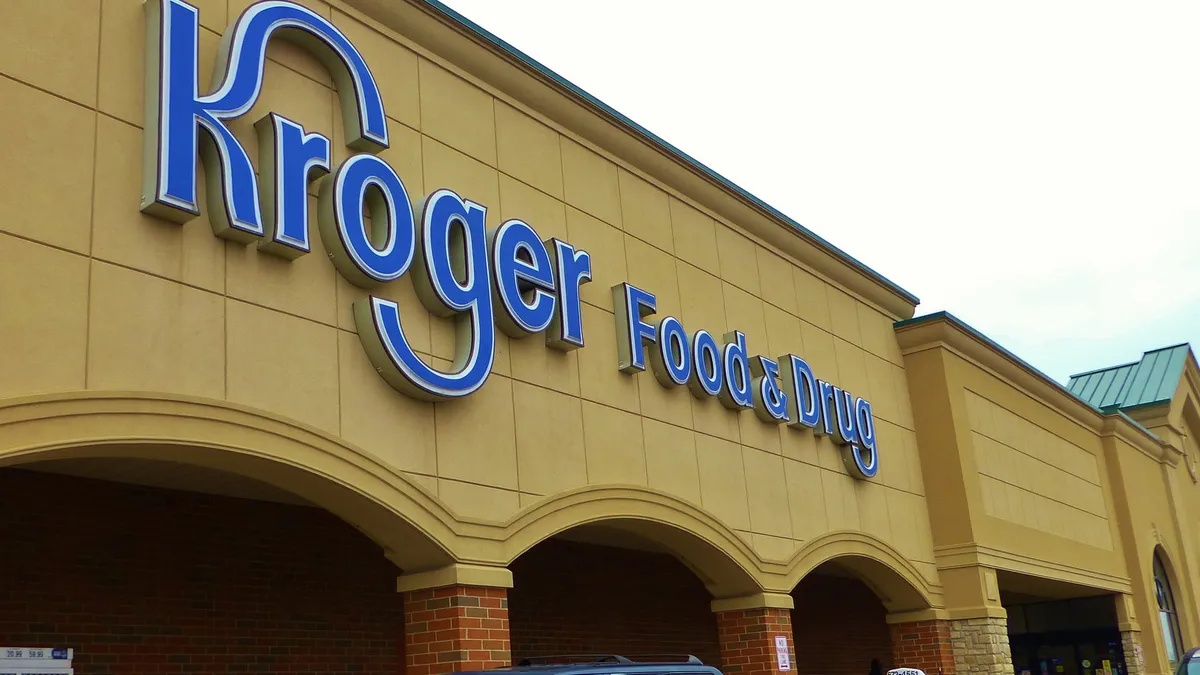Dive Brief:
- Kroger reported earnings of $397 million, or $0.44 per diluted share, in its third financial quarter of 2017, according to a company release. This marked a 12% increase over last quarter, and the highest profits the company has earned so far this year.
- Same-store sales for the company, excluding fuel, were 1.1%, beating the Wall Street consensus of 0.9%. Kroger also beat analysts’ estimates by growing its gross margins to 22.4% for the quarter, and maintaining its adjusted earnings per share estimate of $2 to $2.05.
- "Customers are recognizing our efforts to redefine the customer experience and rewarding us with their loyalty," Kroger CEO Rodney McMullen said in the release. "We continue to accelerate our digital and e-commerce offerings, to grow Our Brands, to lower prices for customers, and to invest in our associates."
Dive Insight:
Coming into this third-quarter earnings report, industry analysts were focused primarily on Kroger’s competitors and what their recent results could mean for the company.
Walmart, for one, just posted 2.7% same-store sales growth to go along with its strongest food sales in six years. This indicates the mega-retailer is gaining market share, which is worrying for Kroger since 80% of its stores sit within five miles of a Walmart, according to a report from Barclays. Although Walmart and Kroger have traditionally served different consumer demographics, both are seeking to broaden their reach through price investments, online shopping, store remodels and investments in fresh products.
Whole Foods, meanwhile, posted a fourth-quarter sales increase of 4.4%, according to a company filing with the Securities & Exchange Commission. This signals Amazon’s recent price cuts are having a positive impact on sales, though sustained traffic growth has remained elusive, recent data has shown.
Against this backdrop, analysts expected Kroger to post flat or slightly declining results. But the retailer’s growth — albeit modest — shows that it’s still one of the savviest companies in the industry. It’s also a sign that Kroger’s turnaround plan unveiled in October — dubbed Restock Kroger — is gaining traction. That initiative is focused on generating more value from existing stores by leveraging data, investing in e-commerce, focusing on high-impact items and more. Kroger wants to deepen and accelerate its development in these areas even as it whittles down costs.
Kroger investors seem to be on board with the plan, with the company’s stock surging 12.9% after the announcement. This earnings report will give them further confidence, as indicated by the 6% surge in pre-market trading this morning.
Moody's Vice President Mickey Chadha reacted positively to the report in written comments emailed to Food Dive.
“Kroger’s better than expected third quarter results demonstrate that its new initiatives under its restock plan are gaining traction," he wrote. "Particularly impressive was the 109% increase in digital revenue driven by Click list, the company’s order online and pickup in store initiative and the 30 basis point improvement in year over year gross margin for the quarter with a 1.1% increase in ex-fuel identical store sales despite continuing pricing pressure/”
Highlights from the report include a 30 basis point improvement in gross margins to 22.4%, along with the increase in digital revenue from Kroger’s ClickList service. Kroger has been fairly aggressive with its e-commerce growth of late, and should be able to at least retain customers against Walmart’s store pickup expansion.
Kroger also highlighted new initiatives launched during this most recent quarter, including the launch of an online portal for local suppliers, the opening of its first standalone restaurant and the development of new private label offerings in apparel and floral.
Despite these better-than-expected results, Kroger shouldn't rest on its laurels. The company is under tremendous pressure from Walmart, Amazon, discounters and a strong class of traditional retailers. The nation’s largest grocer is laser focused on growing market share through price cuts. At the same time, it’s fighting for better margins with merchandising improvements and investments in promising new categories.
Industry observers agree that Kroger’s size and industry savvy will help it withstand an increasingly competitive, price-focused market. But these latest results show the company may be on more of a growth trajectory than many expect.










